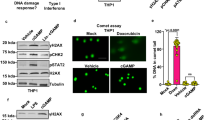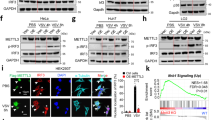Abstract
Adenosine deaminases acting on RNA (ADARs) catalyze hyperediting of long double-stranded RNAs (dsRNAs), whereby up to 50% of adenosines are converted to inosine (I). Although hyperedited dsRNAs (IU-dsRNAs) have been implicated in various cellular functions, we now provide evidence for another role. We show that IU-dsRNA suppresses the induction of interferon-stimulated genes (ISGs) and apoptosis by poly(IC). Moreover, we show that IU-dsRNA inhibits the activation of interferon regulatory factor 3 (IRF3), which is essential for the induction of ISGs and apoptosis. Finally, we speculate that the inhibition of IRF3 results from specific binding of IU-dsRNA to MDA-5 or RIG-I, both of which are cytosolic sensors for poly(IC). Although our data are consistent with a previous study in which ADAR1 deletion resulted in increased expression of ISGs and apoptosis, we show that IU-dsRNA per se suppresses ISGs and apoptosis. We therefore propose that any IU-dsRNA generated by ADAR1 can inhibit both pathways.
This is a preview of subscription content, access via your institution
Access options
Subscribe to this journal
Receive 12 print issues and online access
$189.00 per year
only $15.75 per issue
Buy this article
- Purchase on Springer Link
- Instant access to full article PDF
Prices may be subject to local taxes which are calculated during checkout







Similar content being viewed by others
Change history
24 August 2010
In the version of this article initially published online, there was a formatting error in the sequences shown in Table 1. The error has been corrected for the print, PDF and HTML versions of this article.
References
Bass, B.L. RNA editing by adenosine deaminases that act on RNA. Annu. Rev. Biochem. 71, 817–846 (2002).
Valente, L., Nishikura, K. & Kivie, M. ADAR gene family and A-to-I RNA editing: diverse roles in posttranscriptional gene regulation. Prog. Nucleic Acid Res. Mol. Biol. 79, 299–338 (2005).
Serra, M.J., Smolter, P.E. & Westhof, E. Pronounced instability of tandem IU base pairs in RNA. Nucleic Acids Res. 32, 1824–1828 (2004).
Blow, M., Futreal, P.A., Wooster, R. & Stratton, M.R. A survey of RNA editing in human brain. Genome Res. 14, 2379–2387 (2004).
Morse, D.P., Aruscavage, P.J. & Bass, B.L. RNA hairpins in noncoding regions of human brain and Caenorhabditis elegans mRNA are edited by adenosine deaminases that act on RNA. Proc. Natl. Acad. Sci. USA 99, 7906–7911 (2002).
Levanon, E.Y. et al. Systematic identification of abundant A-to-I editing sites in the human transcriptome. Nat. Biotechnol. 22, 1001–1005 (2004).
Barak, M. et al. Evidence for large diversity in the human transcriptome created by Alu RNA editing. Nucleic Acids Res. 37, 6905–6915 (2009).
Chen, L.-L., DeCerbo, J.N. & Carmichael, G.G. Alu element-mediated gene silencing. EMBO J. 27, 1694–1705 (2008).
Chen, L.-L. & Carmichael, G.G. Altered nuclear retention of mRNAs containing inverted repeats in human embryonic stem cells: functional role of a nuclear noncoding RNA. Mol. Cell 35, 467–478 (2009).
Hundley, H.A., Krauchuk, A.A. & Bass, B.L. C. elegans and H. sapiens mRNAs with edited 3′UTRs are present on polysomes. RNA 14, 2050–2060 (2008).
Scadden, A.D.J. & Smith, C.W.J. Specific cleavage of hyper-edited dsRNAs. EMBO J. 20, 4243–4252 (2001).
Scadden, A.D.J. The RISC subunit Tudor-SN binds to hyper-edited double-stranded RNA and promotes its cleavage. Nat. Struct. Mol. Biol. 12, 489–496 (2005).
Scadden, A.D.J. Inosine-containing dsRNA binds a stress-granule-like complex and downregulates gene expression in trans. Mol. Cell 28, 491–500 (2007).
George, C.X. & Samuel, C.E. Characterization of the 5′-flanking region of the human RNA-specific adenosine deaminase ADAR1 gene and identification of an interferon-inducible ADAR1 promoter. Gene 229, 203–213 (1999).
Eckmann, C.R., Neunteufl, A., Pfaffstetter, L. & Jantsch, M.F. The human but not the Xenopus RNA-editing enzyme ADAR1 has an atypical nuclear localization signal and displays the characteristics of a shuttling protein. Mol. Biol. Cell 12, 1911–1924 (2001).
Wang, Q. et al. Stress-induced apoptosis associated with null mutation of ADAR1 RNA editing deaminase gene. J. Biol. Chem. 279, 4952–4961 (2004).
Hartner, J.C., Walkley, C.R., Lu, J. & Orkin, S.H. ADAR1 is essential for the maintenance of hematopoiesis and suppression of interferon signaling. Nat. Immunol. 10, 109–115 (2009).
Hiscott, J. Triggering the innate antiviral response through IRF-3 activation. J. Biol. Chem. 282, 15325–15329 (2007).
Kato, H. et al. Length-dependent recognition of double-stranded ribonucleic acids by retinoic acid-inducible gene-I and melanoma differentiation-associated gene 5. J. Exp. Med. 205, 1601–1610 (2008).
Anderson, P. & Kedersha, N. RNA granules. J. Cell Biol. 172, 803–808 (2006).
Stark, G.R., Kerr, I.M., Williams, B.R.G., Silverman, R.H. & Schreiber, R.D. How cells respond to interferons. Annu. Rev. Biochem. 67, 227–264 (1998).
Fire, A. et al. Potent and specific genetic interference by double-stranded RNA in Caenorhabditis elegans . Nature 391, 806–811 (1998).
Grudzien, E. et al. Novel cap analogs for in vitro synthesis of mRNAs with high translational efficiency. RNA 10, 1479–1487 (2004).
Field, A.K. et al. Poly I:C, an inducer of interferon and interference against virus infections. Medicine 51, 169–174 (1972).
Thomas, P.D. et al. PANTHER: a library of protein families and subfamilies indexed by function. Genome Res. 13, 2129–2141 (2003).
Dogusan, Z. et al. Double-stranded RNA induces pancreatic β-cell apoptosis by activation of the toll-like receptor 3 and interferon regulatory factor 3 pathways. Diabetes 57, 1236–1245 (2008).
Besch, R. et al. Proapoptotic signaling induced by RIG-I and MDA-5 results in type I interferon-independent apoptosis in human melanoma cells. J. Clin. Invest. 119, 2399–2411 (2009).
Gorczyca, W., Gong, J., Ardelt, B., Traganos, F. & Darzynkiewicz, Z. The cell cycle related differences in susceptibility of HL-60 cells to apoptosis induced by various antitumor agents. Cancer Res. 53, 3186–3192 (1993).
Lazebnik, Y.A., Kaufmann, S.H., Desnoyers, S., Poirier, G.G. & Earnshaw, W.C. Cleavage of poly(ADP-ribose) polymerase by a proteinase with properties like ICE. Nature 371, 346–347 (1994).
Lin, R., Heylbroeck, C., Pitha, P.M. & Hiscott, J. Virus-dependent phosphorylation of the IRF-3 transcription factor regulates nuclear translocation, transactivation potential, and proteasome-mediated degradation. Mol. Cell. Biol. 18, 2986–2996 (1998).
Yoneyama, M. et al. Direct triggering of the type I interferon system by virus infection: activation of a transcription factor complex containing IRF-3 and CBP/p300. EMBO J. 17, 1087–1095 (1998).
Weaver, B.K., Ando, O., Kumar, K.P. & Reich, N.C. Apoptosis is promoted by the dsRNA-activated factor (DRAF1) during viral infection independent of the action of interferon or p53. FASEB J. 15, 501–515 (2001).
Peters, K., Chattopadhyay, S. & Sen, G.C. IRF-3 activation by sendai virus infection is required for cellular apoptosis and avoidance of persistence. J. Virol. 82, 3500–3508 (2008).
Holm, G.H. et al. Retinoic acid-inducible gene-I and interferon-β promoter stimulator-1 augment proapoptotic responses following mammalian reovirus infection via interferon regulatory factor-3. J. Biol. Chem. 282, 21953–21961 (2007).
Heylbroeck, C. et al. The IRF-3 transcription factor mediates sendai virus-induced apoptosis. J. Virol. 74, 3781–3792 (2000).
Saito, T. et al. Regulation of innate antiviral defenses through a shared repressor domain in RIG-I and LGP2. Proc. Natl. Acad. Sci. USA 104, 582–587 (2007).
Yoneyama, M. et al. The RNA helicase RIG-I has an essential function in double-stranded RNA-induced innate antiviral responses. Nat. Immunol. 5, 730–737 (2004).
Takahasi, K. et al. Solution structures of cytosolic RNA sensor MDA5 and LGP2 C-terminal domains. J. Biol. Chem. 284, 17465–17474 (2009).
Kirshner, J.R., Karpova, A.Y., Kops, M. & Howley, P.M. Identification of TRAIL as an interferon regulatory factor 3 transcriptional target. J. Virol. 79, 9320–9324 (2005).
Leaman, D.W. et al. Identification of X-linked inhibitor of apoptosis-associated factor-1 as an interferon-stimulated gene that augments TRAIL Apo2L-induced apoptosis. J. Biol. Chem. 277, 28504–28511 (2002).
Toth, A.M., Li, Z., Cattaneo, R. & Samuel, C.E. RNA-specific adenosine deaminase ADAR1 suppresses measles virus-induced apoptosis and activation of protein kinase PKR. J. Biol. Chem. 284, 29350–29356 (2009).
XuFeng, R. et al. ADAR1 is required for hematopoietic progenitor cell survival via RNA editing. Proc. Natl. Acad. Sci. USA 106, 17763–17768 (2009).
Blow, M.J. et al. RNA editing of human microRNAs. Genome Biol. 7, R27 (2006).
Kawai, T. et al. IPS-1, an adaptor triggering RIG-I- and Mda5-mediated type I interferon induction. Nat. Immunol. 6, 981–988 (2005).
Wormington, M., Searfoss, A.M. & Hurney, C.A. Overexpression of poly(A) binding protein prevents maturation-specific deadenylation and translational inactivation in Xenopus oocytes. EMBO J. 15, 900–909 (1996).
Du, P., Kibbe, W.A. & Lin, S.M. lumi: a pipeline for processing Illumina microarray. Bioinformatics 24, 1547–1548 (2008).
Acknowledgements
We thank C. Smith for helpful comments, J. Hiscott (McGill Univ.), J. De Miranda (Columbia Univ.) and S. Akira (Osaka Univ.) for reagents, R. Walker (Wellcome Trust Centre for Stem Cell Research) for FACS and E. Clemente and J. Bauer (Cambridge Genomic Services) for microarrays. This work was supported by the Wellcome Trust.
Author information
Authors and Affiliations
Contributions
A.D.J.S. designed the study; P.V. and A.D.J.S. performed the experiments and data analysis; A.D.J.S. prepared the manuscript.
Corresponding author
Ethics declarations
Competing interests
The authors declare no competing financial interests.
Supplementary information
Supplementary Text and Figures
Supplementary Figures 1–6, Supplementary Tables 1–4, Supplementary Methods (PDF 3546 kb)
Rights and permissions
About this article
Cite this article
Vitali, P., Scadden, A. Double-stranded RNAs containing multiple IU pairs are sufficient to suppress interferon induction and apoptosis. Nat Struct Mol Biol 17, 1043–1050 (2010). https://doi.org/10.1038/nsmb.1864
Received:
Accepted:
Published:
Issue Date:
DOI: https://doi.org/10.1038/nsmb.1864
This article is cited by
-
Is the Association of the Rare rs35667974 IFIH1 Gene Polymorphism With Autoimmune Diseases a Case of RNA Epigenetics?
Journal of Molecular Evolution (2023)
-
Z-DNA and Z-RNA in human disease
Communications Biology (2019)
-
ADAR1 controls apoptosis of stressed cells by inhibiting Staufen1-mediated mRNA decay
Nature Structural & Molecular Biology (2017)
-
A-to-I editing of coding and non-coding RNAs by ADARs
Nature Reviews Molecular Cell Biology (2016)
-
The dynamic epitranscriptome: A to I editing modulates genetic information
Chromosoma (2016)



